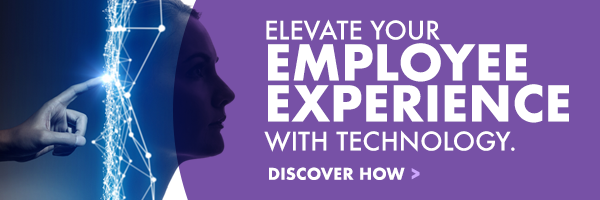Is Your Workplace Technology Pushing Employees Out the Door?


Providing a positive employee experience should be a top priority for every employer. Unfortunately, there is often a disconnect between what an employer thinks its workforce needs and what the workforce actually needs.
There are multiple factors that affect how employees feel about their jobs and their role in the company. But one of the most influential is the type and quality of technology an employer provides.
Here’s how to create a digital workplace that empowers employees.
How Workplace Technology Impacts Employees
In our personal lives, we rely heavily on technology. And when our smartphones suddenly break or we can’t connect to the internet, it’s frustrating but certainly not catastrophic. We can find workarounds to continue our lives at least temporarily.
In our professional lives, however, we rely so completely on technology that in many cases its malfunction or absence means we literally cannot do our jobs.
But insufficient technology has ramifications beyond an employee’s ability to finish their tasks. For instance, frustrations with technology lead to a lack of engagement and decreased job satisfaction. And if the shortcomings of a company’s workplace technology become too much for an employee, that lack of engagement leads to the employee looking elsewhere for a new employer.
The Mismatch Between Employers and the Workforce
In its recent report, global information technology company Unisys explored the effect of technology in the workplace. The study, entitled The New Digital Workplace Divide: Why a Technology-Enabled Workplace is Critical to Business Success, is based on a survey of 12,000 employees in 12 countries.
The goal of the survey was to analyze the effect of technology on employee engagement, productivity and turnover. Its findings demonstrated how remarkably important it is for companies to prioritize their approach to technology in the workplace.
Unisys divided the companies at which these employees worked into two categories: Technology Leaders and Technology Laggards. Not surprisingly, the overall attitude of employees at companies designated as technology laggards had noticeably lower satisfaction and engagement.
Here are a few stats for the working population in New Zealand:
- Fifty-eight percent of employees at technology laggard companies have negative feelings towards their employers. When compared to the 10 percent of the workforce at technology leader companies who feel the same, the difference is over 480 percent.
- Forty-nine percent of employees working at technology laggard companies report having to get by with outdated devices. This is 3x the number of employees employed with a technology leader.
- Nearly a third of non-IT-supported software downloads were the result of an employee needing an up-to-date tool the company didn’t provide or for which the company didn’t offer a comparable alternative.
- The shortcomings of employer-provided smartphones has resulted in 43 percent of employees using their personal devices for work, which makes the company more vulnerable to security risks.
“The research underscores how the digital workplace encompasses a wide ecosystem of people, culture, technology and processes,” says Leon Sayers, lead advisory consultant for Unisys Asia Pacific. “It’s not just about how up to date your IT is or whether you can log in from home. How you work defines your workplace—and vice versa. To achieve successful digital transformation, employers must take a holistic approach to organisational change.”
The Solution
Employers recognize turnover is expensive. And most understand the extent to which the workplace affects turnover. However, not every employer appreciates just how much technology impacts the workplace and, in turn, retention and engagement.
In order to keep employees happy and productive, employers must invest in the employee experience. More specifically, they must commit to providing up-to-date, employee-centric technology. Among the elements that define the employee experience, the quality of technology employers provide the workforce can be the greatest influencer.
Here are just a few of the ways technology in the workplace can substantially improve the employee experience:
Employee Performance Measurement
Annual and even quarterly reviews are on the way out. How an employee performed in January will be substantially different from how he or she performed 10-11 (or even 3-4) months later. So it doesn’t make sense to check in that infrequently.
Instead, employers should offer the workforce technologies that give the employee on-demand access to their progress towards achieving their goals and how their work is impacting the company. This empowers employees to not only proactively course correct but also to see the positive contributions of their work.
Understand How Employees Are Feeling
In addition to objectively measuring an employee’s performance, supervisors must understand how employees feel about their job on a more emotional level.
Apps like Officevibe and 15Five give employees the opportunity to give supervisors quick status updates as well as voice concerns on a weekly basis. Employee responses in these apps give supervisors better insight into what they can do to help their team feel more engaged.
Enhance Collaboration
There will almost assuredly be members of your workforce who prefer to work more on their own. On the flipside, you also have employees who thrive in a team-focused environment.
Regardless, an employee’s work doesn’t exist in a vacuum. Both types of employees need to be able to easily communicate with other team members. And the technologies you offer employees should be designed to meet the needs of individuals with different communication styles.
Technology is just one many things that impact the employee experience, but as this research shows, it’s a crucial factor. Make sure your employees have technology that not only supports their productivity and efficiency but also their overall happiness.
For more statistics on how technology impacts the employee experience—including research by author Jacob Morgan—check out our latest guide.
